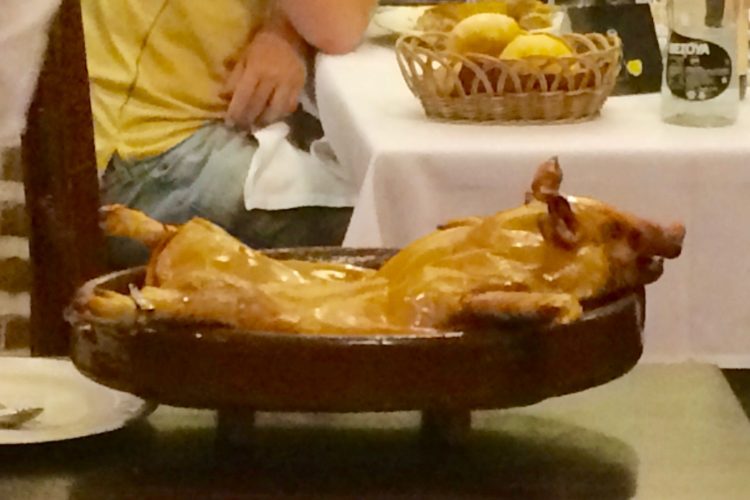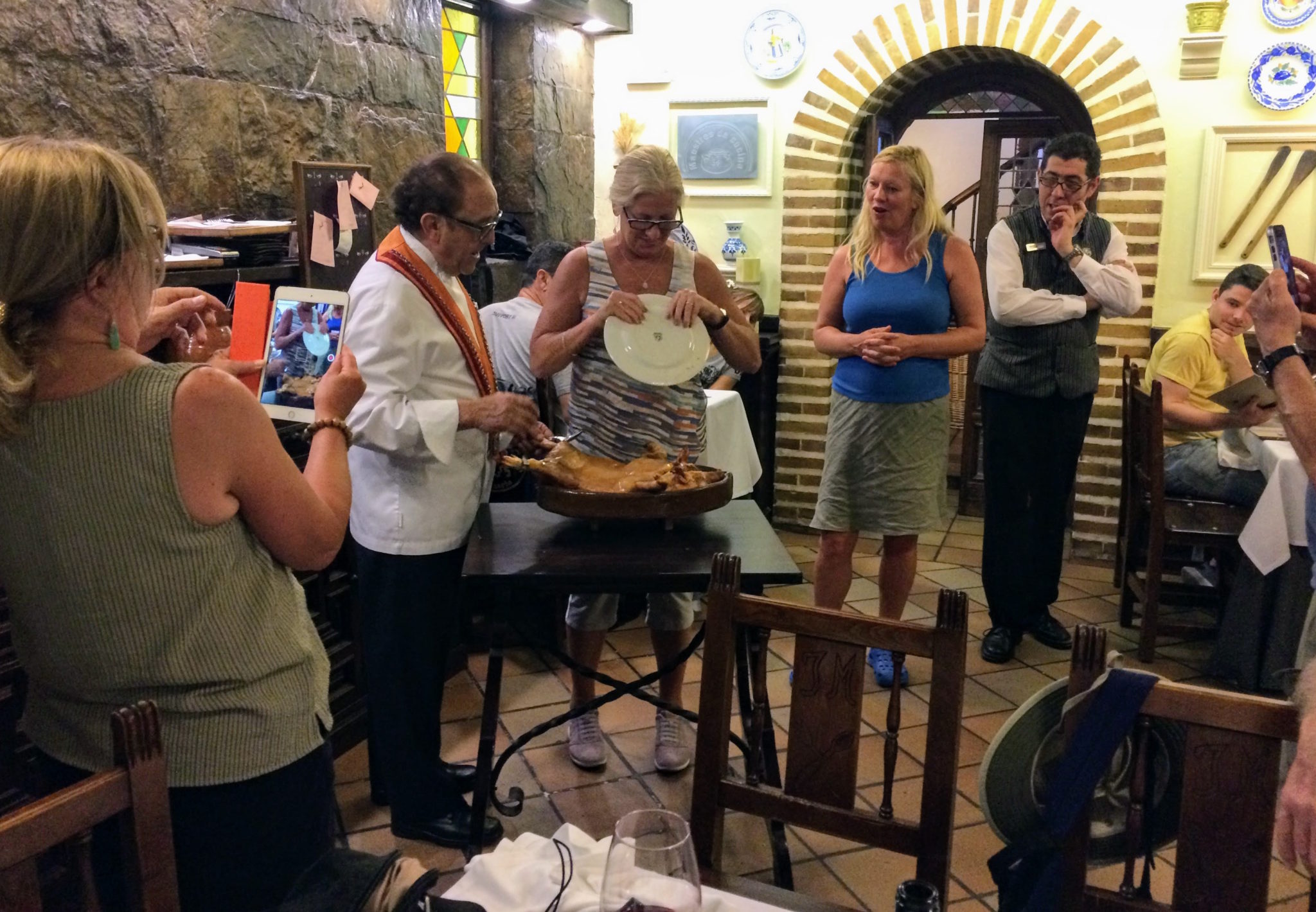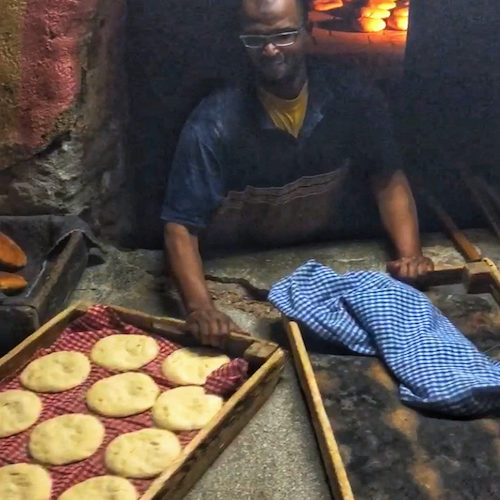I wanted to eat the air. I think that's a first for me.

Being a good traveler: When is it okay to say “no”?
Dear Piglet and Wilbur,
I am very, very sorry. I repaid years of your loyal friendship and entertainment by munching on one of the youngest and tenderest of your piggy brethren. I know that you have forgiven me in the past for delighting in bacon and ham, but I’m afraid I crossed a line. Adding insult to injury, I didn’t even really enjoy it. ––Very sincerely yours, Caroline.
You are, perhaps, wondering what the heck that was all about. Last week I was going through some pictures from my trip to Spain and came across one of the roast suckling pig that I had in Segovia. As you can probably guess, this is an experience that, nearly a year later, I am still ambivalent about, and it got me thinking about how much I associate trying local cuisine with being a “good” traveler.

The infamous pig…
Definitions vary (there is even an entire, very pretentious, debate about the difference between “travel” and “tourism”), but I think that most people want to be “good” travelers/tourists. (I am treating these terms as synonymous because this is my blog and I get to make these decisions.) And I think most people would agree that that means embracing new experiences and occasionally eating something that you’d really rather not. But where is the line between keeping an open mind (and stomach) about a new culture and being comfortable saying, “uh, no, not gonna happen?”
This is not an issue limited to food, of course. Travelers can have invisible lines in the sand about all kinds of issues–politics, history, social policies, etc.–but I’m not surprised that, for me, food is one of the places where this question surfaces. In my family, the link between food, open-mindedness, and “good” traveling was forged early on.
Food and the Good Traveler
I was a very well-behaved kid, so my mother had few explicit rules (believe me, that changed when I became a teenager and discovered I had a very smart mouth). But of the rules she did have, not one but two involved food–and they were non-negotiable. I had to try, really try, everything, and I was never to refer to any food as “gross” or “disgusting” or any other descriptive or disparaging word. In return, if I really didn’t like something after several bites, I didn’t have to finish it, and it wouldn’t appear again (though, there were some things that she did sneakily reintroduce every couple of years. I eventually caved on mushrooms and green olives, but never gave an inch on peppers. Peppers are still my nemesis. Unless they’re in a still-life painting, I don’t want them near me.).
My mother was my first travel companion and this attitude accompanied us wherever we went. Trying new foods, or even eating familiar foods that were prepared in different ways (or just looked different, like the unpeeled shrimp that drove my eleven-year-old self to tears), was meant to be a major part of the experience.
And my mother did not conceal her disapproval of other tourists who were less adventurous. And if they were unadventurous and rude, then disapproval became disdain in a hurry. Once, when I was twelve, we were sitting in a restaurant in Athens and overheard the party at a nearby table making a bit of a fuss. One of the men was giving the server a hard time about how his meat was seasoned and cooked (I remember very clearly my mother saying, “does he think he’s in a steakhouse?”). Later on, the entire table became very jolly and rather loud. At one point my mother leaned across the table and explained in a low voice, “that’s what people mean why they call somebody an ‘Ugly American.’”
I don’t think I’d actually heard that term before, and I was certainly too young to grasp all its nuance, but I did understand that it was not something I wanted to be. And though I don’t remember, I wouldn’t be surprised if I then finished my own dinner with a slight feeling of smugness.
As I entered my teens, my mother’s attitude toward food became a periodic source of conflict between us, though more often than not, it was just one of the many things at which my charming adolescent self rolled my eyes. If you had asked me what I thought of my mother’s food rules, and especially about her food-and-travel attitudes, I am sure I would have said something snarky.
It wasn’t until I was studying abroad that I realized how deeply her opinions had affected me. Sometime between my orientation meal in Edinburgh–where I was one of the few students in my cohort willing to try haggis (though, I confess, I only did so because I knew that I “had” to)–and my spring break wanderings (when I, having run low on money, found myself at a German Burger King and felt genuinely embarrassed)–it dawned on me that I had become a believer.
I am so sorry, little piggies…..
Like I said, it was the memory of that roast suckling pig that got me started on these musings. The dish is a speciality of Segovia and must be prepared to certain strict specifications at every stage to rate as the “real thing.” Pigs must be milk-fed only, from a mother who has herself had a special diet, and they cannot be more than three weeks old when butchered. This careful preparation, combined with the skill of Segovia’s elite chefs, results in a delectable dining experience.
And certainly a unique one, too. For instance, there are no knives involved. To demonstrate just how tender the meat is, the pig isn’t carved with a knife but rather with–yes, you’re reading this correctly–an ordinary ceramic plate. In fact, in some restaurants they later break the plate in front of patrons to assure them that it was not concealing any sharp edges, that the meat really is just that tender.

I really thought I was going to be okay with all of this. After all, I eat meat, own and wear leather goods, and dissected a fetal pig back in ninth grade, so, no big deal, right? And at first, everything was okay. I didn’t feel the need to watch the “carving” too closely, but the first couple of bites were, indeed, amazingly tender and juicy, and it was easy to understand why this is such a prized delicacy.
But after a few minutes, I couldn’t eat anymore. And a few minutes after that, I was nauseous. There was nothing wrong with the food, it was all in my head. Whether it was the visions of Piglet and Wilbur–well-loved porcine figures from my childhood–in my head, or the fact that I had been able to identify the part of the pig I was eating (complete with, um, facial feature…), there was just no way I was going to be able to finish. And when the waiter came by to collect my still nearly-full plate, I’m pretty sure I didn’t imagine the strange look he gave me. It was very, “don’t you understand how special this is????”

My plate. It was as tender, juicy, and flavorful as it looks, but I still couldn’t manage more than a few bites.
What is a “Good Traveler,” anyway?
I still think that it’s important to be open to new foods when traveling. Food is an intrinsic part of any culture and you really do miss something if you forego the local cuisine in favor of Pizza Hut. Moreover, like everything else about travel, the opportunity to taste local cuisine–and especially local delicacies–is a privilege, and one I don’t think I should disregard lightly. So I am going to continue to value an open mind on these matters and be grateful to my mother for raising me that way.
But I also think I will be avoiding eating dead animals that look too much like, well, dead animals, even though that makes me feel a little guilty. And I have to wonder, was my mother’s view too black and white? At what point is it “okay” to reject out of hand part of a culture (whether food or anything else)? Is it an entirely arbitrary distinction? Or might the entire conversation be just yet another semi-snooty way for some travelers to look down their noses at others?
What do you think? Are there any travel lines in the sand (whether about food or something else) that you just won’t cross? On a less philosophical note, what is your most memorable food experience while traveling? Let me know in the comments section!




Hello, recent tour mate! I am very much enjoying your blogs. This should not have been the first one I commented on. But ever since eating that delicious suckling pig in Segovia back in 2015, I have greatly reduced my dining on young mammals! I prefer to recall what an interesting town it was-a castle, a cathedral with an Inquisition past, a royal castle and an aqueduct. To think we spent just a day there.
Just wanted to thank you for your well-written, insightful commentary and pics. They will help get me through until Keith and I travel again-hopefully next summer.
-Lisa